Welcome home marine debris COASSTers! On this page you will find data sheets, training videos, and answers to our most frequently asked questions about your surveys. If you’d like to join COASST marine debris surveys, please visit the Join Our Team page to read more about our program.
Mapping Your Survey
Determine the random sample locations for your small and medium debris surveys each month using our Mapping Your Survey app. You’ll need your beach name and the paces per meter measurement for this month’s pacer.
Data Sheets
The latest versions of the COASST data sheets can be found below. You should complete a copy of the Cover Sheet during each survey, but you only need to fill out a Small, Medium, or Large Debris Data Sheet if you find debris. Click to download a pdf.
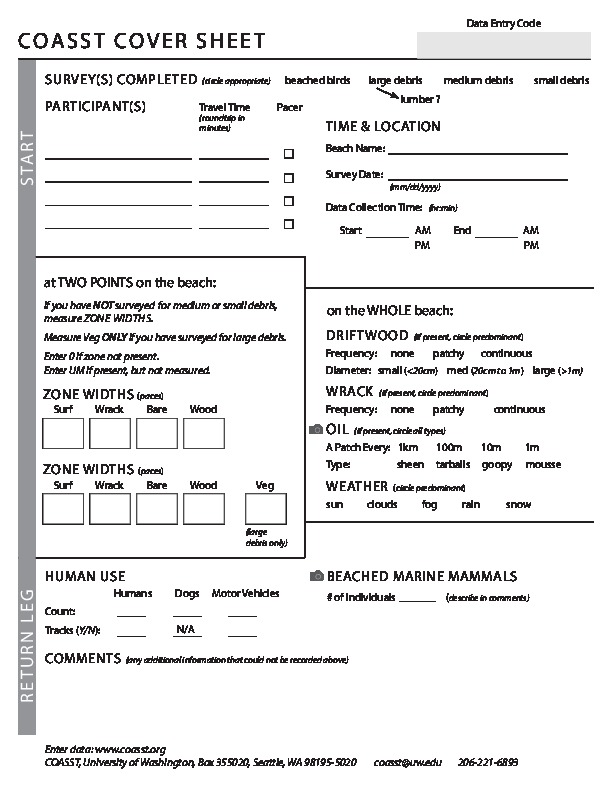
COASST Cover Sheet
This 2-pager is a COASST Cover Sheet with a Mapping Your Survey form on the back, appropriate for Small and Medium Debris surveys.
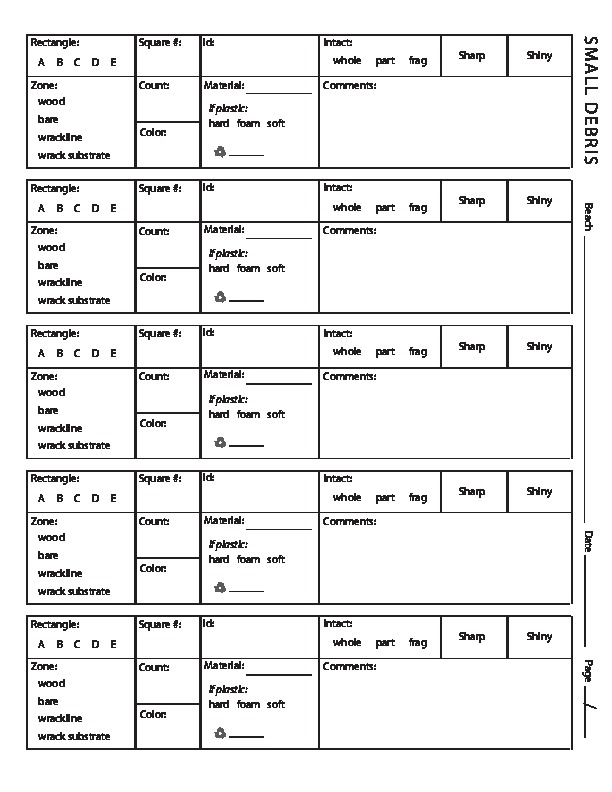
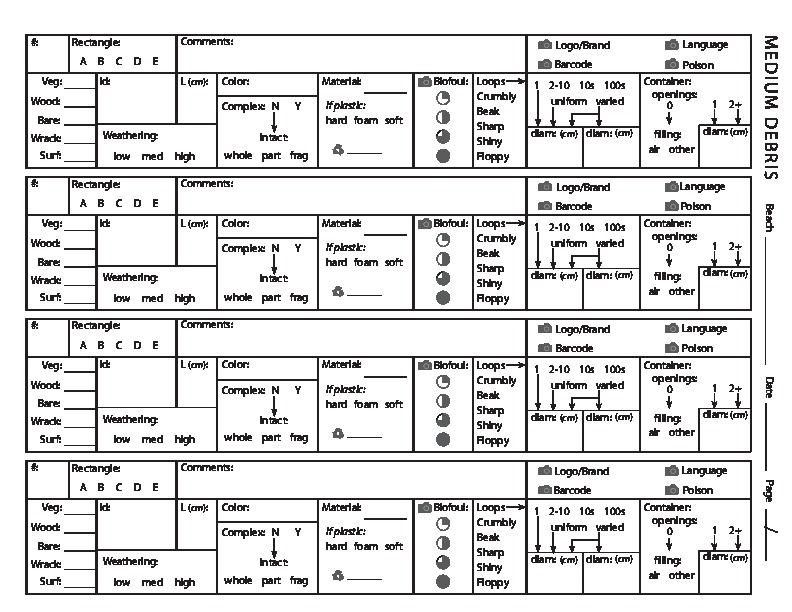
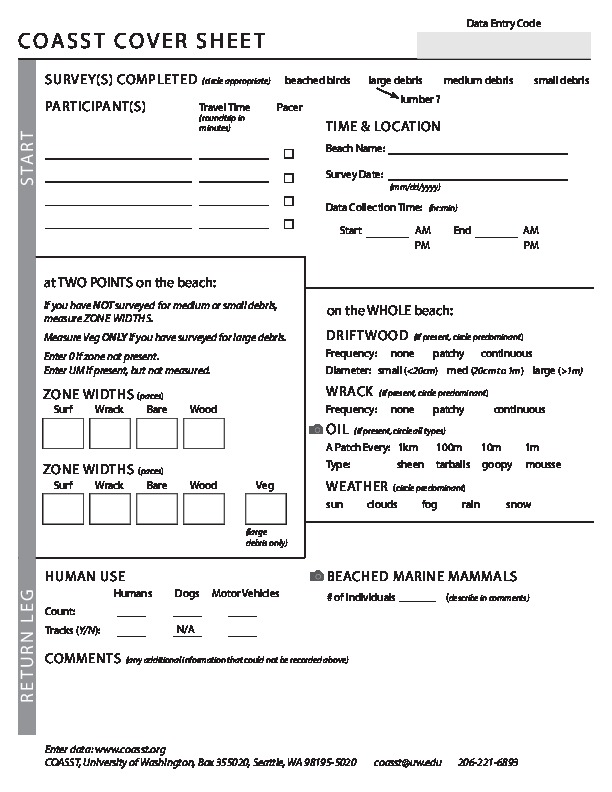
COASST Cover Sheet
This 2-pager is a COASST Cover Sheet with a Large Debris Data Sheet on the back.
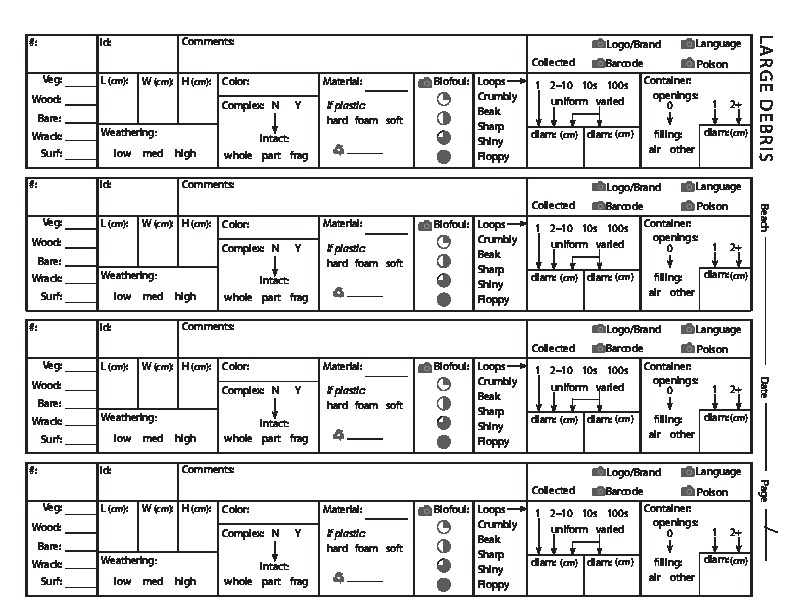

Paces Per Meter Worksheet
This one-sided worksheet will guide you through the calculation of your paces per meter. We only need this information from you once, when you join our program! After that your personal measurement will be stored in our database.
Training Videos
Mapping Your Survey
Each Small or Medium Debris survey is conducted at 3-5 random points across your beach. Here’s a video describing how to set up your 5-meter rectangles each month.Sampling Small Debris
How to use your sampling square to survey the beach for small debris (2.5mm-2.5cm).Sampling Medium Debris
How to use your 5-meter rope to survey the beach for medium debris (2.5cm-50cm).Walk the Line
How do you determine your personal paces per meter measurement? Here’s a video describing the steps pace the beach and complete the paces per meter worksheet.Get in the Zone
How do you measure and record each zone on your beach? This video describes zones and pacing.Digital Deep Dives: refresher recordings
Intactness: Whole, Part, Fragment
This presentation covers a recent change to the COASST MD datasheet, and focuses on the difference between intactness characteristics: whole, part, and fragment.Mystery Debris Identities and Characteristics
In this video we explore some of our most recent debris identity mysteries (including a Russian sonobuoy!) and share tips and tricks for identifying a few characteristics that are important for tracking the impacts of marine debris: Floppy/Loopy, Sharp/Shiny, and Biofouled.Invasive Green Crab
Crab Team’s Emily Grason shares the story of the green crab invasion on the West Coast, and helps COASSTers learn to identify and report molts and crabs on their surveys (links in the FAQ section below!)Debris Impacts: Harm to Wildlife Characteristics
In this video we discuss a few characteristics that indicate a particular debris item might be harmful to wildlife: color and entanglement characteristics floppy and loopy.Debris Impacts: Sourcing Characteristics
In this video we discuss characteristics that indicate the source of debris items. To visit the Nurdle Patrol site go nurdlepatrol.orgData entry for marine debris surveyors
In this video we will discuss tips and tricks for entering data online, viewing changes as they are verified, and places to exploring on the COASST website.Marine mammal reporting
In this video we discuss the reporting of marine mammals, on and off COASST marine debris surveys. Our participants can find stranding network numbers at this address: https://www.fisheries.noaa.gov/report and more identification resources at this address: https://mmapl.ucsc.edu/resources.Weird Debris
In this session, we identify marine debris items that are often found but not often recognized.Streamlining Debris Characterization: Large Debris Examples
In this video we cover large marine debris, including when and how to tally and characterize abundant and persistent items like lumber, bricks and concrete.Streamlining Debris Characterization: Medium Debris Examples
Sorting and tallying are strategies to streamline marine debris characterization. This video is a recording of a live demonstration using medium debris samples.Determining Beach Zones on Marine Debris Surveys
In this video, we review the what, where, why and how of beach zones during marine debris surveys, with many examples of tricky delineations using COASSTer submitted photos.FAQs
Pacing is used to measure the distance between sampling rectangles for small and medium debris. It also helps us measure the beach zones.
Knowing the approximate width of a beach, and of the zones comprising that total width, allows COASST to create a more accurate estimate (statistical model) of the true density (debris per unit area) of things.
The presence and width of beach zones can indicate two important things:
1. The likelihood of detection: wood and wrack zones can “hide” the presence of debris.
2. Accumulation: birds, debris and other flotsam are deposited and “stick” to each beach zone differently.
Yes. Substrate type, solidity/looseness, uphill/downhill steepness, weather, and other favors can affect the accuracy of the paces per meter (paces/m) measurement, which COASST uses to convert zone widths from paces back into meters.
COASST is all about appropriate precision. For instance, the length of debris items is recorded in centimeters because we compare the size of the debris to the size of the bird or mammal that might consume that item – accuracy to the centimeter here allows us to rule out which animal mouths are small or large enough to mistake the debris for prey of an identical length. Much larger distances, like beach zone widths, or lengths down the beach where marine debris rectangles are located, can sustain a coarser unit of measurement. Neither of these purposes require sub-meter, or even meter accuracy.
For marine debris sampling locations, pacing is a simple way to get from one location to the next. The important points are to have these locations randomly selected each survey and distant enough from each other so that there is no interference.
For beach zone widths, pacing is a simple way to get a general indication of the relative size of each zone. That is, what proportion of the total beach width each zone comprises.
It is important for COASST to know the difference between no data (that is, no measurements were made), absence of one or more zones, and a zone was present but not surveyed due to extenuating circumstances like safety concerns. Here is how COASST would like you to distinguish:
If a zone is not present (e.g., there is no wrack, or no wood at the location you are measuring the zone widths), record a “0” (literally, a zone width of zero) on your datasheet.
If a zone is present but not surveyed for safety reasons (e.g., a wood zone of large slippery logs or a surf zone of mudflats), put a “UM” (stands for unmeasured) on your datasheet.
If a zone is present and you choose to estimate its width rather than actually pace it (e.g., same scenario as above), write a comment indicating you estimated instead of actually paced.
If multiple zones appear to be present in equal levels, follow the following hierarchy:
When wrack and surf are present, call it wrack.
When wood and wrack are present, call it wood.
If vegetation and any other zone are present together, call that zone vegetation.
Like most other things in COASST, think in terms of predominance. The vegetation zone begins when vegetation becomes a consistent on the section of beach that you are measuring. A few sparse plants don’t count. An odd log or two does not constitute a wood “zone”, but an area where many logs have accumulated does.
Wrack is (almost) all of the floating material deposited by the tide. Obviously most of the wood on a beach came in on the tide at some point, usually during storms where big waves have “thrown” the wood high up on the beach, which would include material that makes up the wood zone.
Think of the wrack as the material that has been deposited on successive days of the tidal cycle. It is all of the small stuff (i.e. seaweed, shells, Velella velella, and marine debris) that could easily be washed away and re-deposited in the next days of the tide washing in and out.
Wrack may include some wood pieces, but it is less likely that a continuous line of large logs washes in and out daily on the tide. That more permanent line of wood would be defined as the wood zone.
The COASST protocol has instructions for measuring zone widths on a simplified beach (knowing that all COASST beaches are different, and may be quite different from the version in the protocol). Using the start and turnaround points as places of measurement are suggested because these are known locations that are convenient, and at which you are literally walking the width of the beach anyway.
If these locations are not convenient, or are not “typical” of your beach (i.e. the start and turnaround points are actually roadways where vehicles enter the beach), don’t use them! Instead, select two locations that are typical and that are convenient to how your team surveys the beach.
Here are some general guidelines:
- Choose two locations along your beach that you feel are “typical” of the beach on that day.
- Make sure they are not right next to each other—they should be at least 50 paces apart from one another.
- If it is easier to establish these as set locations (same place every time), then do that. On the other hand, if the beach is tremendously variable across time so that you feel that choosing locations each time is better, then do that.
- Don’t worry about the absence of zones, the beach is what it is. For example, if a storm deposits wrack from the surf zone up into the vegetation, then you’ve got a darned wide wrack zone! You can always annotate in the comments section on the COASST cover sheet.
- Know that the surf zone will always be the most variable in width, because of the tide.
That’s OK! What’s most important is that:
You select locations that are “typical” of your beach.
You select locations that are easy (hence the guidelines to pace at the start and turnaround points, because you enter the beach from the back and can easily walk down towards the water, counting paces per zone as you go, and vice versa walking up the beach at the turnaround). If you access the beach from somewhere other than one of the ends, use the general guidelines listed above.
A live marine mammal doesn’t need to be recorded on your COASST Cover Sheet (except in the comments section of course!)
Depending on your location, there are different marine mammal stranding networks who will respond to a live marine mammal in distress.
Before you survey, check NOAA’s reporting website to find the number of your local stranding network to carry with you on your survey.
If you can only fit one number in your phone, choose this one: the NOAA West Coast Stranding Hotline 1-866-767-6114. These folks will redirect you and your information to the local network.
Each stretch of coastline has its own local marine mammal stranding network that either records reports for a national database or responds to individual calls to collect additional data.
Before you head out to the beach, take a look at these links to find your local beached marine mammal network number. If you can call from the beach and give explicit directions to the location of the carcass, the stranding networks are often able to follow up and collect additional information after you head home.
West Coast Marine Mammal Stranding Networks
Alaska Marine Mammal Stranding Networks
Please also record each beached marine mammal on the COASST cover sheet. When you submit photos along with your description, it helps the experts in the office make an identification!
If you can only fit one number in your phone, choose this one: the NOAA West Coast Stranding Hotline 1-866-767-6114. These folks will redirect you and your information to the local network.
If there is a hazardous spill on your beach please call the US Coast Guard’s National Response Center at 1-800-424-8802 (toll free from the USA) or 1 (202) 267-2675 (direct dial). Reports can also be made online at www.nrc.uscg.mil.
There are numerous wildlife rehabilitation agencies across the coast. Depending on where you live, you’ll get in contact with a different local agency. Here are a few pages with directories where you can locate a local organization:
Here’s a reminder about some of the key ID features, from our partners at WSG Crab Team.
As for reporting, it depends on where you survey!
ALWAYS write a note about your discovery in the comments section of your cover sheet, and take a picture with your scale ruler so we can help confirm the species. In addition:
If you live in Alaska, green crab reports can help pinpoint the ‘invasion front’.
- call 1-877-INVASIV
- or to use the Alaska Dept of Fish and Game online reporter
- in Kenai you can also visit Kenai Invasives
If you live in Washington, reports can trigger immediate response by WSG Crab Team. Leave all crabs in place, but a molt (just the shell!) can be collected to help confirm ID.
- if you survey inside waters, report your crab finding to Crab Team’s Reporting Page
- if you survey the outer coast, let the COASST office know about your findings
If you live in Oregon or California, the green crab invasion is well established. Harvesting crabs themselves is also legal. You can learn more at the following links:
- Oregon: The Seadrift Green Crab Project
- California: South Slough NERR (2020 Green Crab report)
